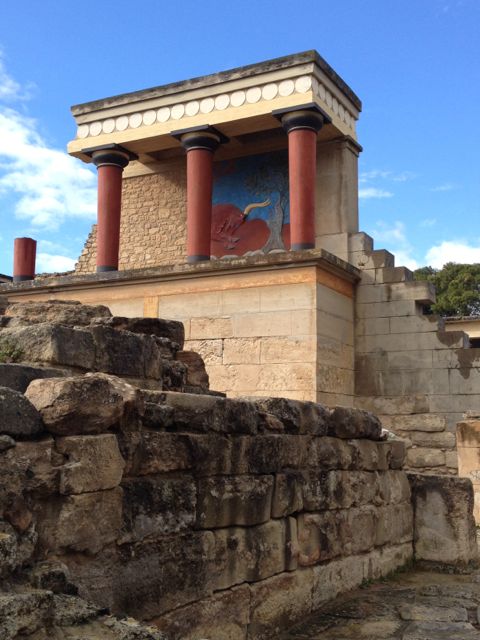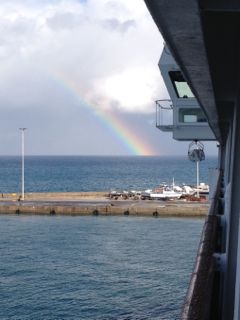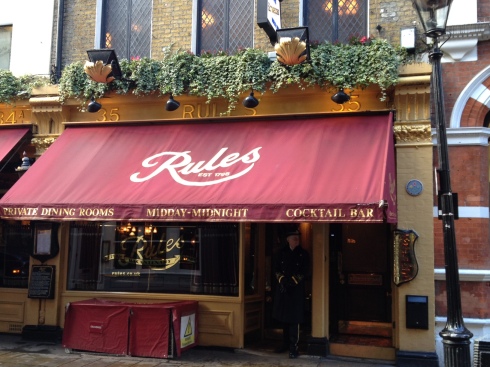 Somehow Oman isn’t anything like what I expected. To the degree that I ever thought about the country before this trip, it was to lump it together with Yemen and think of it as a poorer, strife-ridden cousin of a place like Dubai or Kuwait. Well, I have a new perspective. It appears very modern, prosperous and peaceful.
Somehow Oman isn’t anything like what I expected. To the degree that I ever thought about the country before this trip, it was to lump it together with Yemen and think of it as a poorer, strife-ridden cousin of a place like Dubai or Kuwait. Well, I have a new perspective. It appears very modern, prosperous and peaceful.
Sailing into Muscat is beautiful. High mountains ring the city. The waters are clear. The old earth colored fortress and the white minarets of the mosques define the skyline.
We decide to take a daylong tour titled the Enchanting Forts of Nizwa. This tour of four forts will take us a hundred or so miles inland and through the Hajar Mountains.
As the bus wends westward, the landscape reminds me of Palm Springs and its environs. Tall mountains circle a sere, flat valley bisected by a broad freeway. There is little vegetation, and there are broad, dry washes from when it does rain. The many modern housing developments favor a heavy planting of palm trees. On the outskirts of Muscat, there is a long row of lavish car dealerships, representing every European, American, Japanese and Chinese car manufacturer (and a couple I don’t know). And don’t forget the Pizza Hut, McDonalds, Burger King and Hardees franchise restaurants along the highway.
Just add a heavy dose of crenellations to the house rooftops (Omanis seem to want everything to look like the old fortresses that dot the landscape). And instead of encircling the developments with gates and walls, they separate each property with its own tall wall and entry. And change all the highway and store signs to display both English and Arabic. And, of course, dress the men in white robes and cover the heads of all the women.
Oh . . . and ensure that there is no sign anywhere of litter, graffiti, poverty, homelessness, or potholes. And then tell me that there are no taxes of any kind and that gas sell for about $1 for three liters. Okay, I guess it’s not so much like Palm Springs after all. When you sit on a pool of oil and have a benevolent Sultan, life is different.
But back to the forts. We visit the 17th century fort called Nizwa and the major souk, or marketplace that borders it. We also stop at the very impressive Bahla fort and tour Jabrin Castle—which has a particularly impressive set of painted ceilings. This castle was once the palace of the emir. All of the stops offer impressive views and lots of staircases to clamor about.
In addition, every fort we visit is either beautifully restored or in the process of reaching that state. Apparently, the current Sultan is a strong proponent of restoration and preservation. However, some of my fellow passengers disapprove. Apparently they prefer decaying ruins. They complain it looks too much like the Morocco pavilion at Disney’s Epcot; incredibly they think things look too clean and grumble that like in Disneyland, you can’t buy a drink. (I give them a pass. I’m sure they’re just trying to be clever, and that’s why I pass along their words.)
In the meantime, I am eager for our next stops in Abu Dhabi and Dubai, which promise to show off spectacular modern architecture.
Robert adds: I have just (more or less) recovered from the small cold I caught. There is something that is jokingly referred to as “cruise ship croup”—especially on ships with predominantly older passengers. It’s basically a phlegmy and rheumy cough that makes its way from cabin to cabin, deck to deck. Honestly, in one of the lectures last week, I felt like I was sitting in the middle of a tuberculosis ward in an asylum back in the 1880s. But do these people stay in their cabins to recuperate? No they do not.
My own illness was just a day of sore throat followed by the inevitable (for me) cold. Nothing a good dose or two of Nyquil couldn’t conquer, but I did spend almost an entire day indoors and sleeping. Thanks to my medical professional siblings for always stressing that advice to me over the years.
But because I was only just starting to feel chipper, I did not go with Dennis on his 9-hour tour, but instead took the shuttle into the heart of Muscat town and walked around for a couple hours. I got to take my time and really watch the people go about their business. The souk marketplace was mostly crowded with tourists. (Our ship was just one of three docked in the harbor that day, and we are currently chasing them on our way to the next port. I hope our paths diverge soon because it just overwhelms some ports when there are multiple ships at the same time.)
I was able to concentrate on small details like the ornamentation around a window, the shape of a street lamp, and the decorative concrete tiles of the sidewalk. And as I’ve done on previous worldly visits, I found a couple street cats to sit down with and exchange a few meows. It’s a nice international language. We ended the day with a glass of champagne under the stars on the back deck of the ship, looking out at the colorful lights of the Muscat harbor. Just then, the minarets came alive with the musical call to prayer over their loudspeakers. It was a perfect way to end the day in Oman.
To check out Dennis’s novels, visit www.amazon.com/author/dennisfrahmann
 Last night proved to be a perfect time for looking at stars. On our many sea days between Crete and Oman, we had just entered the Arabian Sea. As darkness fell, the sea settled into the calm of a placid lake, with only the lightest of mists drifting above the water’s surface. No clouds masked the near full, but already waning, moon, and we were told Jupiter was visible just above the horizon. The night air was still and balmy—ideal weather for being outdoors.
Last night proved to be a perfect time for looking at stars. On our many sea days between Crete and Oman, we had just entered the Arabian Sea. As darkness fell, the sea settled into the calm of a placid lake, with only the lightest of mists drifting above the water’s surface. No clouds masked the near full, but already waning, moon, and we were told Jupiter was visible just above the horizon. The night air was still and balmy—ideal weather for being outdoors. Considering that we first reserved this cruise over a year ago and that we subsequently told dozens, if not hundreds, of people about the ship’s itinerary, one might think we would have figured out all the countries that we would pass on our eight sea days from Crete to Oman, via the Suez Canal. (A journey about as long as crossing the continental United States.)
Considering that we first reserved this cruise over a year ago and that we subsequently told dozens, if not hundreds, of people about the ship’s itinerary, one might think we would have figured out all the countries that we would pass on our eight sea days from Crete to Oman, via the Suez Canal. (A journey about as long as crossing the continental United States.) While Robert and I missed Athens, our next day in the Cretan port of Heraklion and a visit to the nearby ancient palace of Knossos was truly memorable. For those who might not know their ancient Mediterranean civilizations, the Minoan culture was centered here long before the rise of the Greeks. They appeared to have been a prosperous and peaceful population of traders who understood the value of running water and flushing toilets. Unfortunately for them, a massive volcano eruption some 3400 hundred years ago (the one that created the incredible caldera harbor in Santorini) resulted in earthquakes, tsunami, and fire that pretty much leveled their main center called Knossos. Their massive dark storerooms of olive oil were only lit by lamps, so when the earthquake dropped those open flames into the oil, the fire raced through the complex built with a heavy use of wooden beams for structural support. Everything collapsed. The alabaster walls are still darkened from the flames.
While Robert and I missed Athens, our next day in the Cretan port of Heraklion and a visit to the nearby ancient palace of Knossos was truly memorable. For those who might not know their ancient Mediterranean civilizations, the Minoan culture was centered here long before the rise of the Greeks. They appeared to have been a prosperous and peaceful population of traders who understood the value of running water and flushing toilets. Unfortunately for them, a massive volcano eruption some 3400 hundred years ago (the one that created the incredible caldera harbor in Santorini) resulted in earthquakes, tsunami, and fire that pretty much leveled their main center called Knossos. Their massive dark storerooms of olive oil were only lit by lamps, so when the earthquake dropped those open flames into the oil, the fire raced through the complex built with a heavy use of wooden beams for structural support. Everything collapsed. The alabaster walls are still darkened from the flames.
 Sailing into the dock for Valetta, Malta makes me feel as though I’m a character in a Game of Thrones novel. The heavily fortified walls of the multiple isthmuses that surround the main harbor are lined with tall ramparts of aged limestone and truly suggest one of the most intriguing places I’ve ever been. It looks like a place that Brianne of Tarth should visit.
Sailing into the dock for Valetta, Malta makes me feel as though I’m a character in a Game of Thrones novel. The heavily fortified walls of the multiple isthmuses that surround the main harbor are lined with tall ramparts of aged limestone and truly suggest one of the most intriguing places I’ve ever been. It looks like a place that Brianne of Tarth should visit.






 But back to Rules. The place is marked by high ceilings, gilded wood paneling, white tablecloths, waiters in tuxedos and a plethora of antlers of every type adorning the walls. The menu celebrates all the wildlife of the English countryside. The walls are also bedecked with a variety of prints of English actors and writers over the ages. There’s a reason that a pivotal scene of Downton Abbey involving Lady Mary was filmed in its interior.
But back to Rules. The place is marked by high ceilings, gilded wood paneling, white tablecloths, waiters in tuxedos and a plethora of antlers of every type adorning the walls. The menu celebrates all the wildlife of the English countryside. The walls are also bedecked with a variety of prints of English actors and writers over the ages. There’s a reason that a pivotal scene of Downton Abbey involving Lady Mary was filmed in its interior. As usual on our city jaunts, we wanted to visit a new restaurant. This time we chose Neal Fraser’s Redbird, nestled in the peaceful courtyard of the former St. Vibiana Cathedral in downtown L.A. It was a jarring transition to move from the decrepit streets of the central city to that elegant interior, where a crowd of Millennials drank expensive craft cocktails and dined on exotic entrees even as a third-world scene co-existed in the surrounding blocks.
As usual on our city jaunts, we wanted to visit a new restaurant. This time we chose Neal Fraser’s Redbird, nestled in the peaceful courtyard of the former St. Vibiana Cathedral in downtown L.A. It was a jarring transition to move from the decrepit streets of the central city to that elegant interior, where a crowd of Millennials drank expensive craft cocktails and dined on exotic entrees even as a third-world scene co-existed in the surrounding blocks.